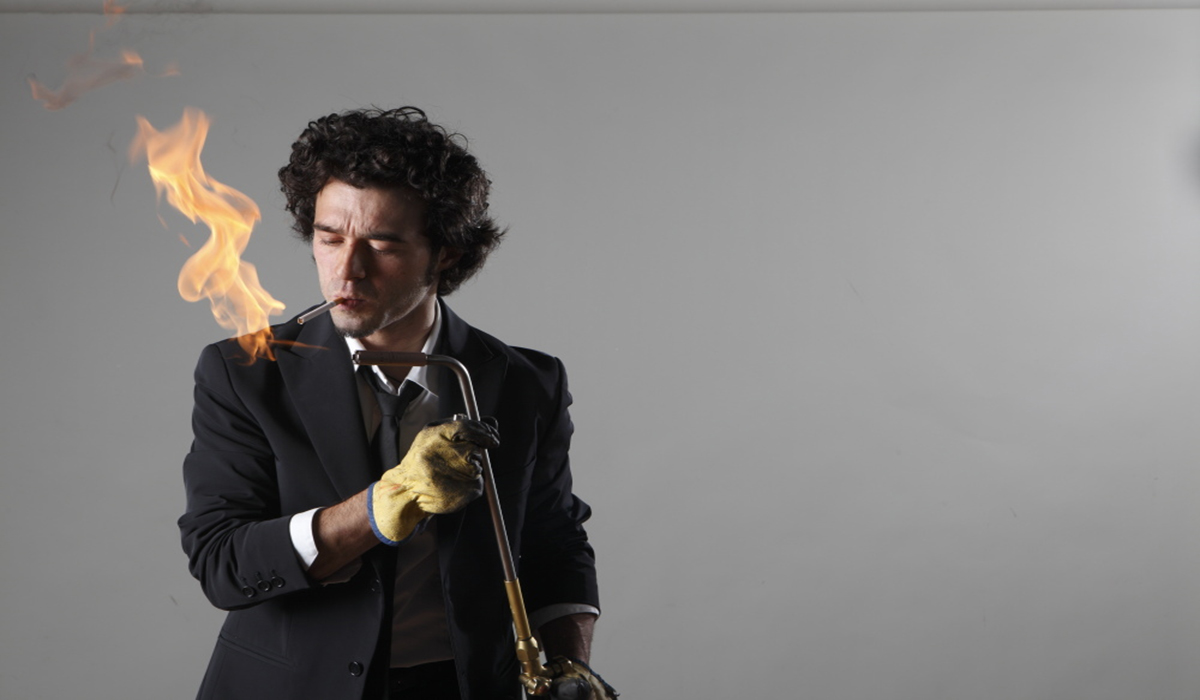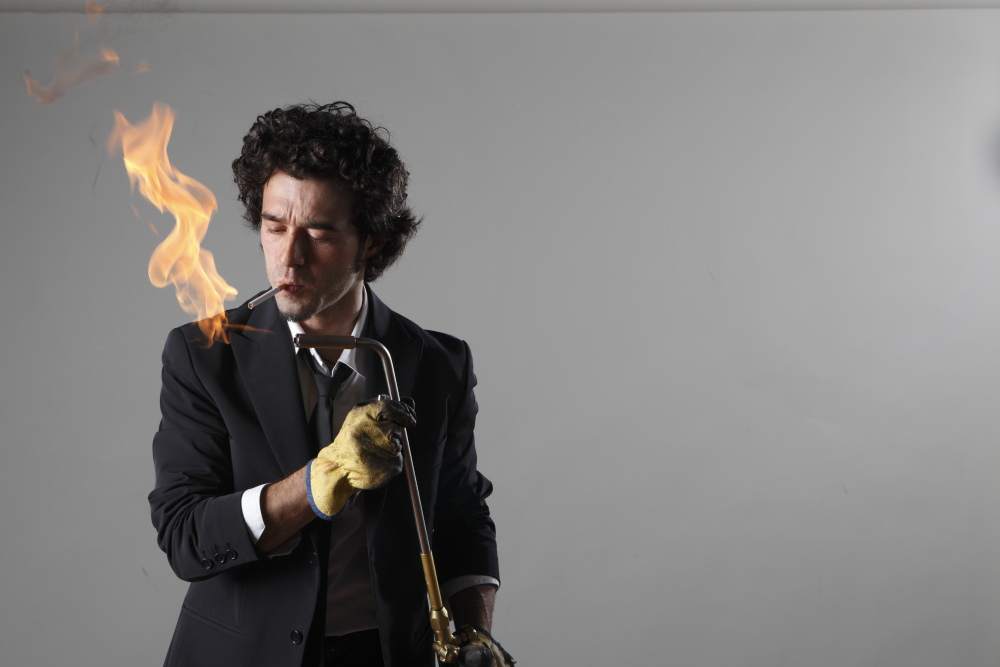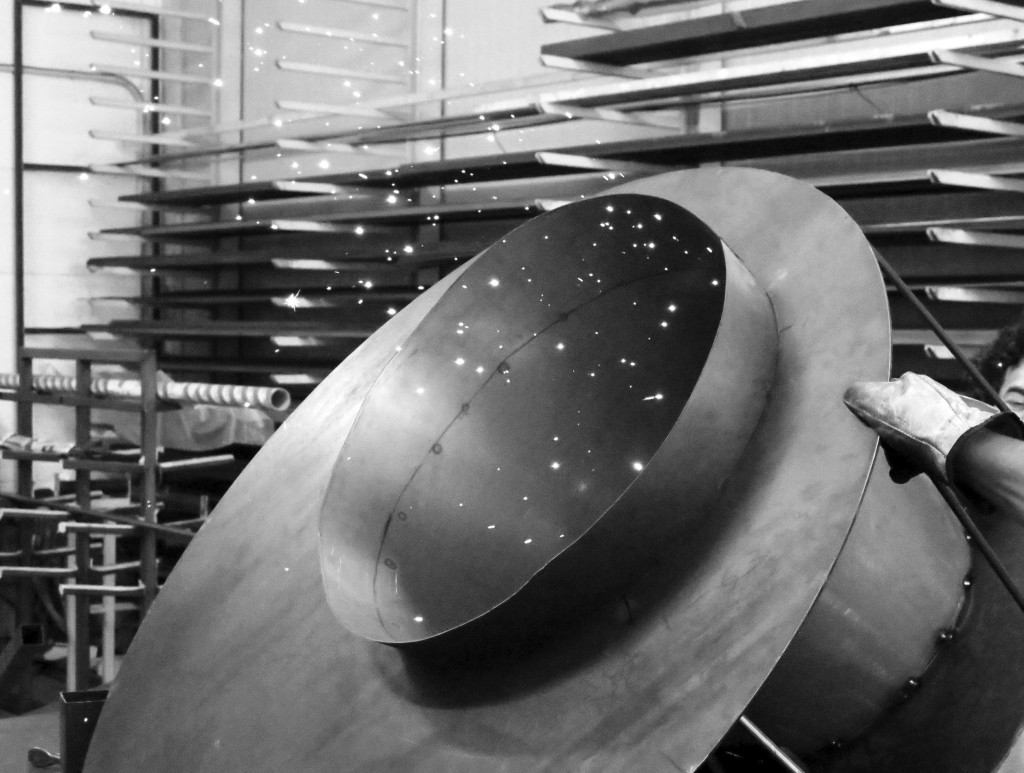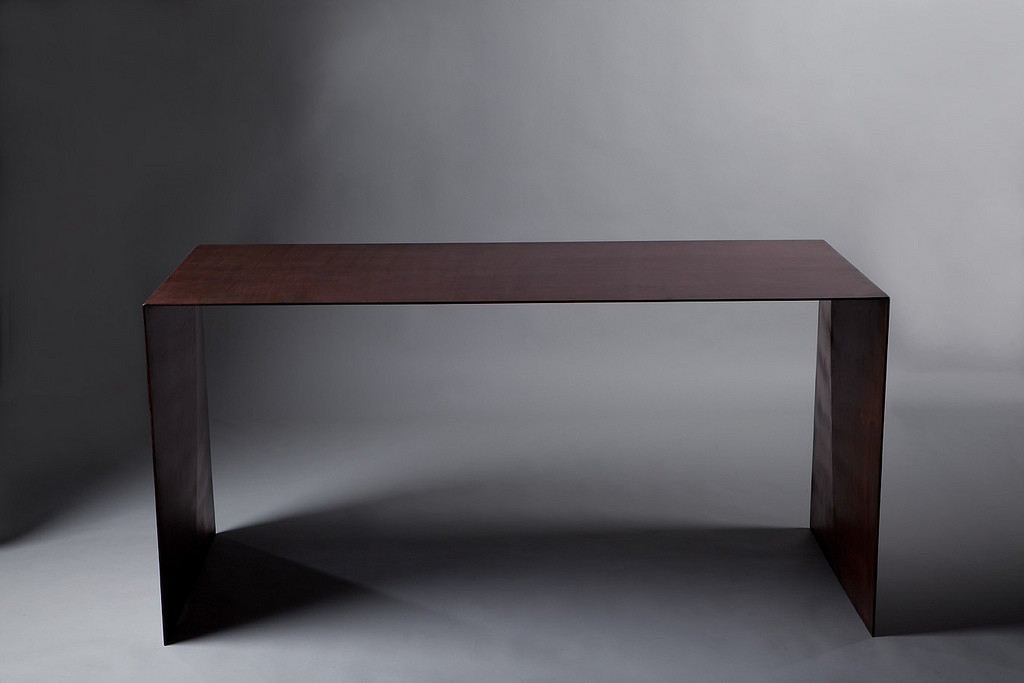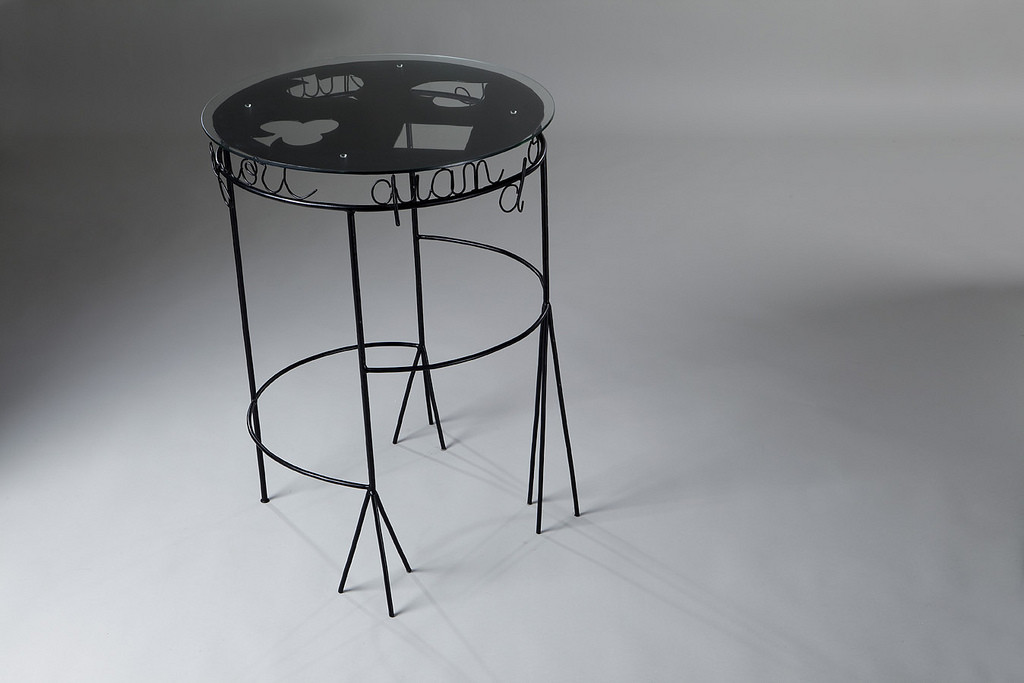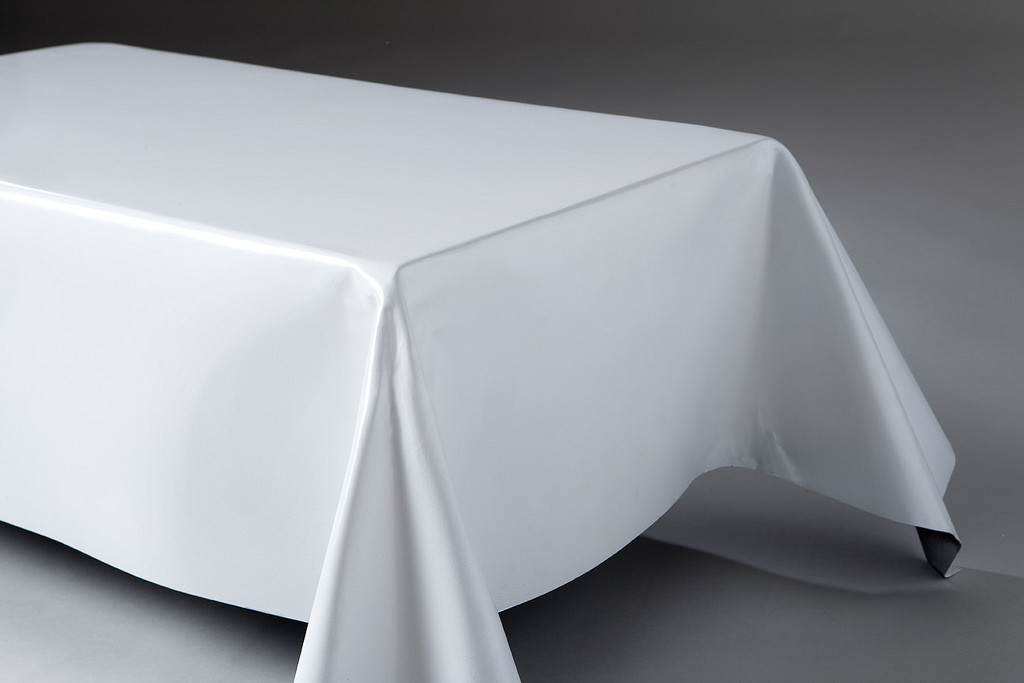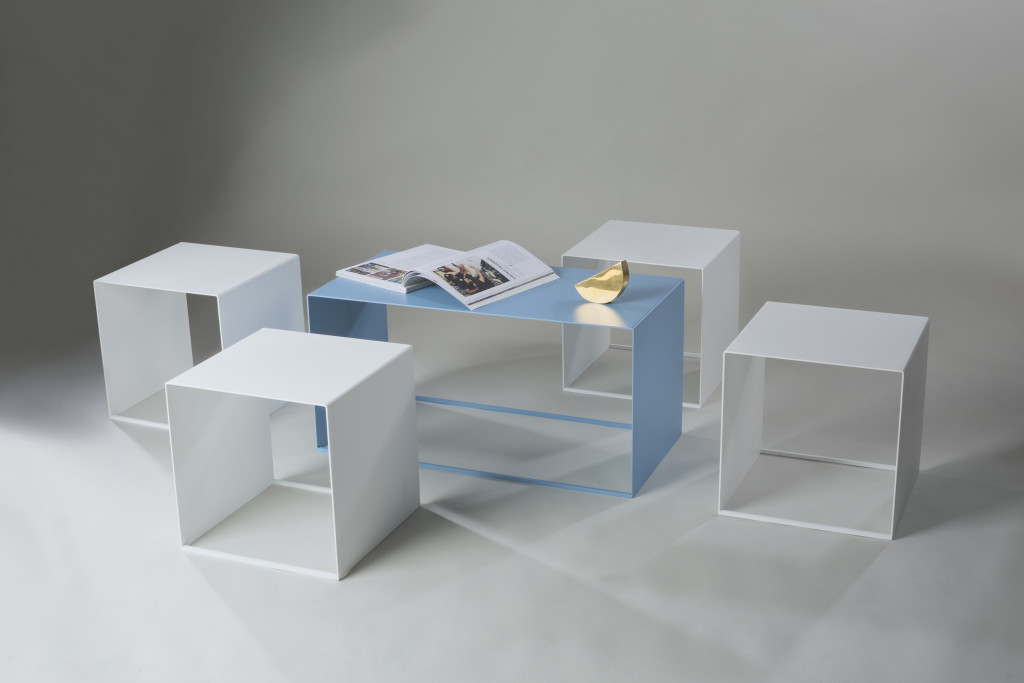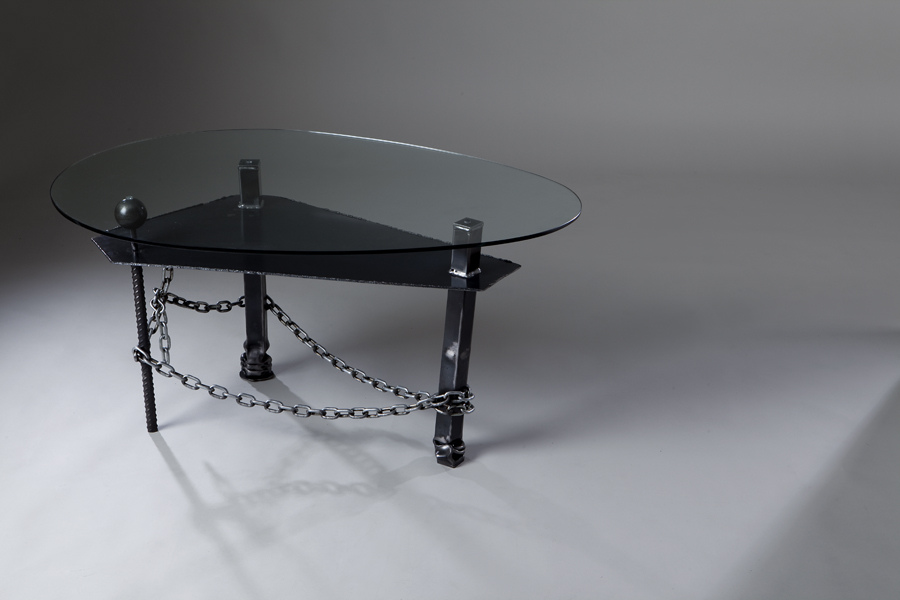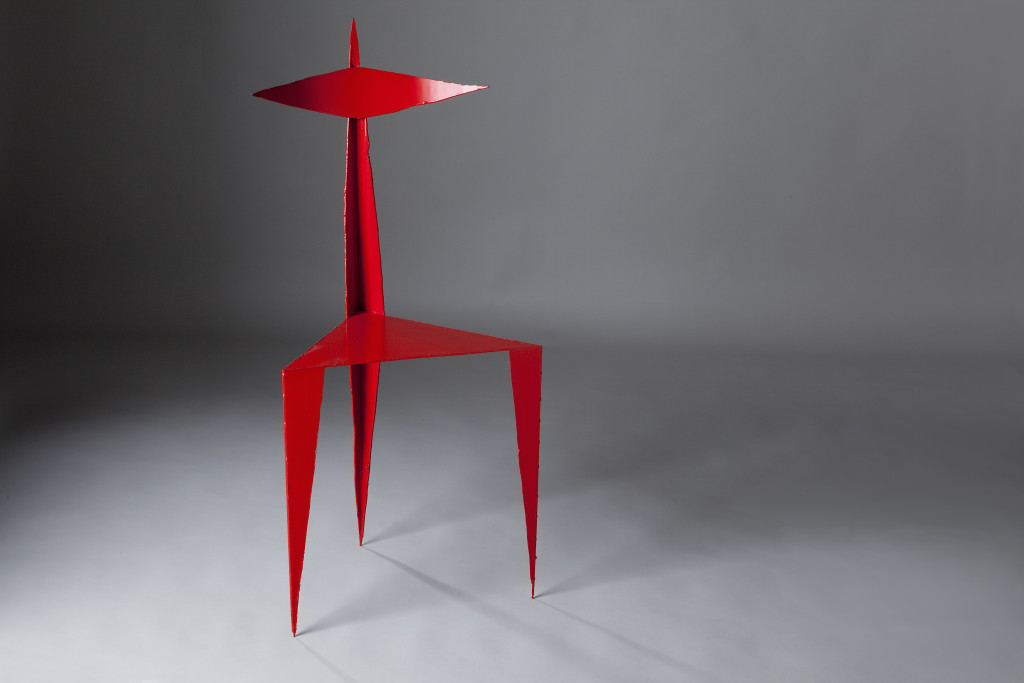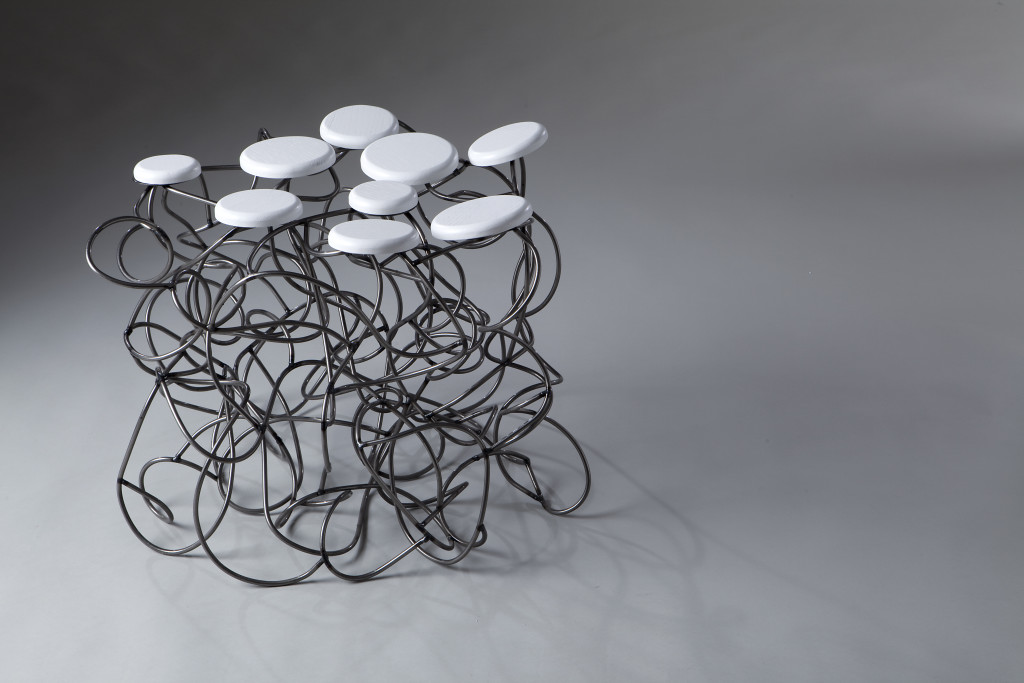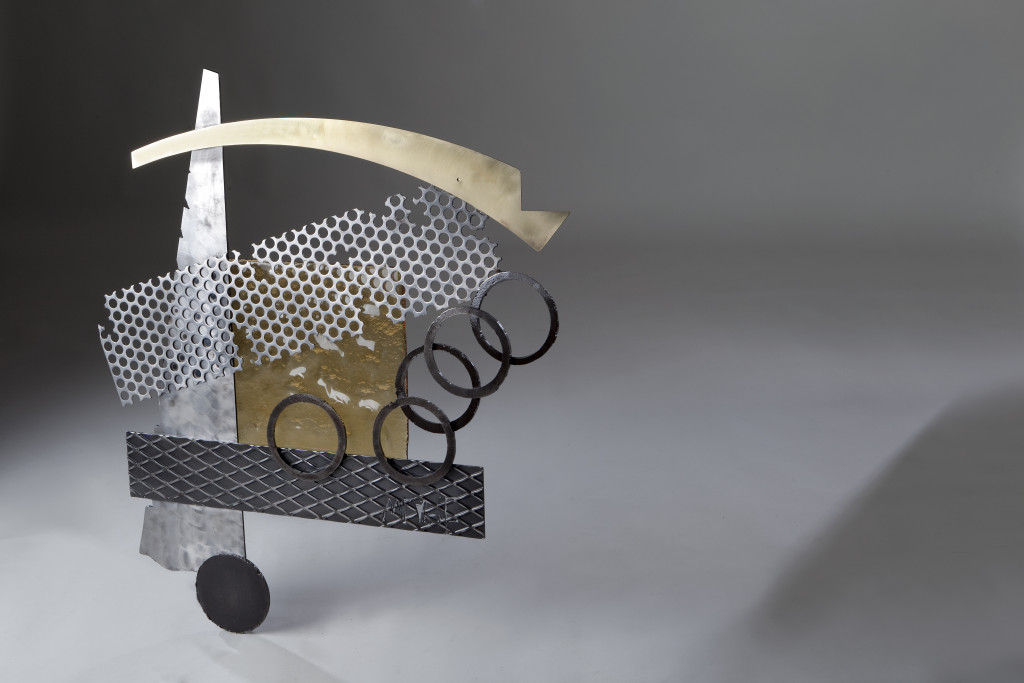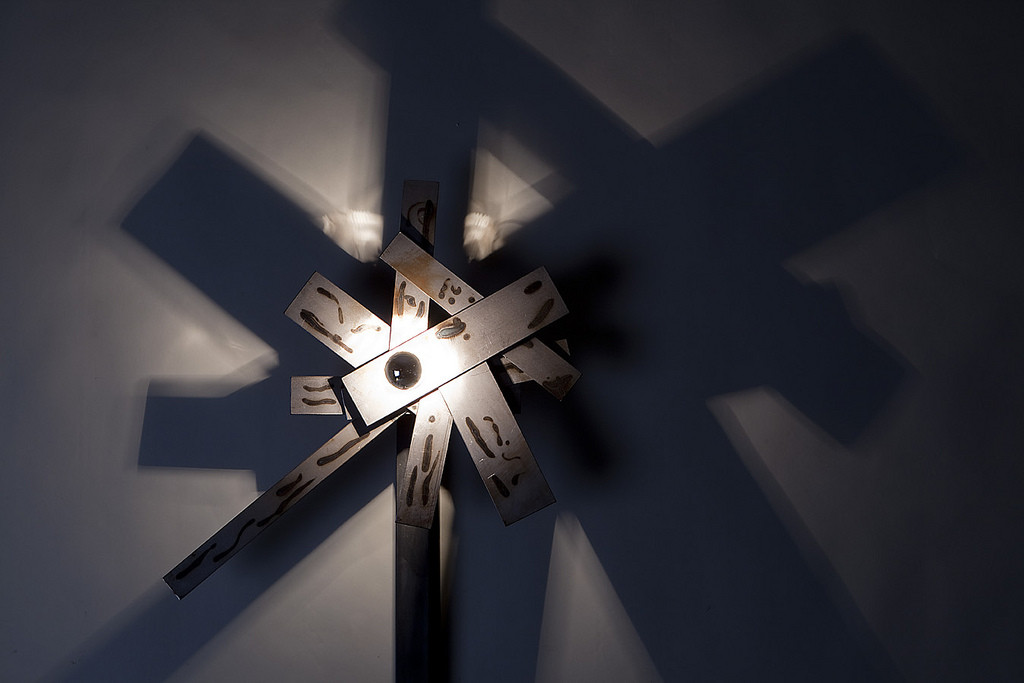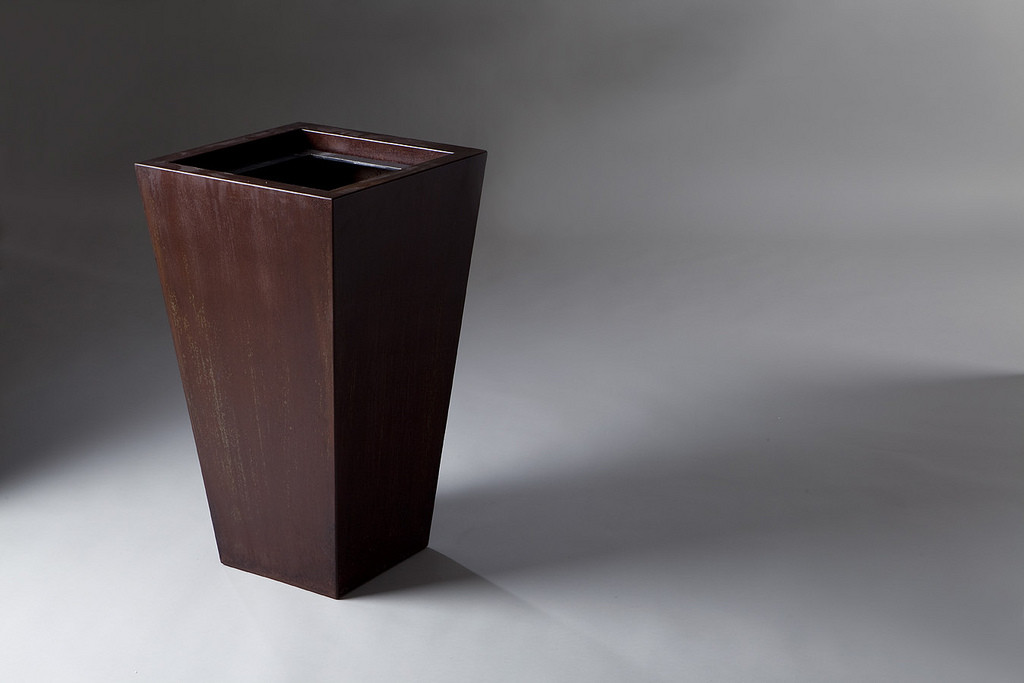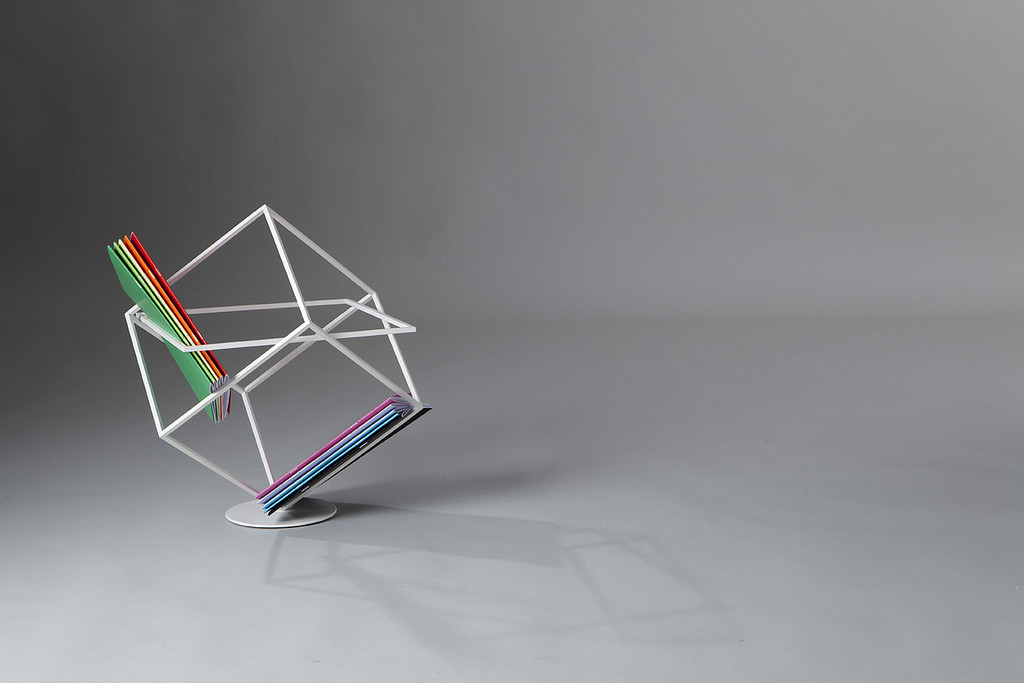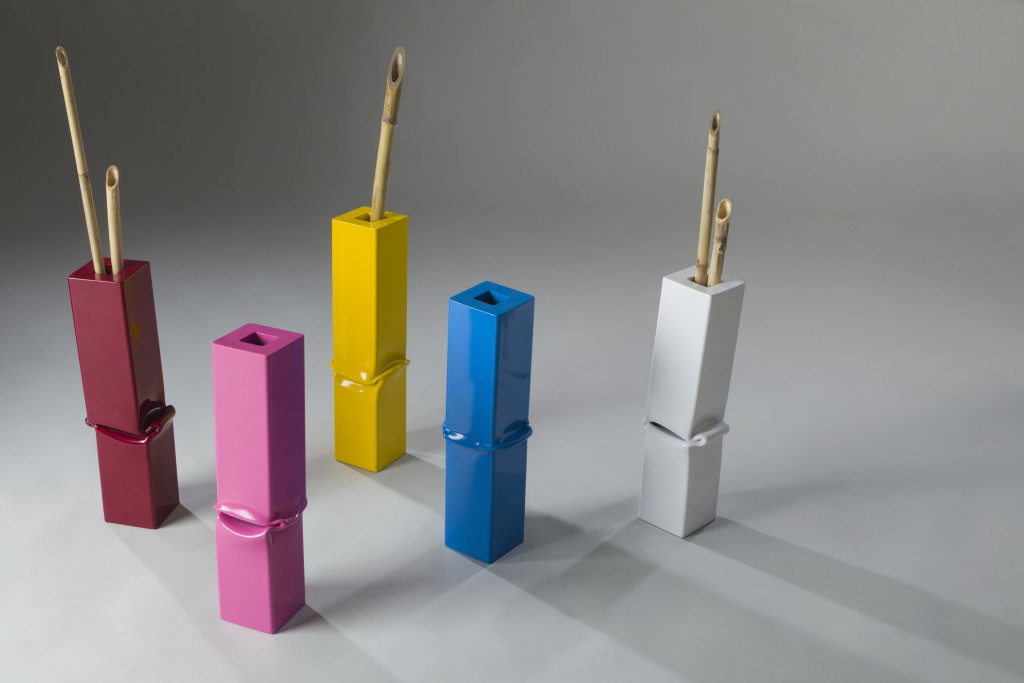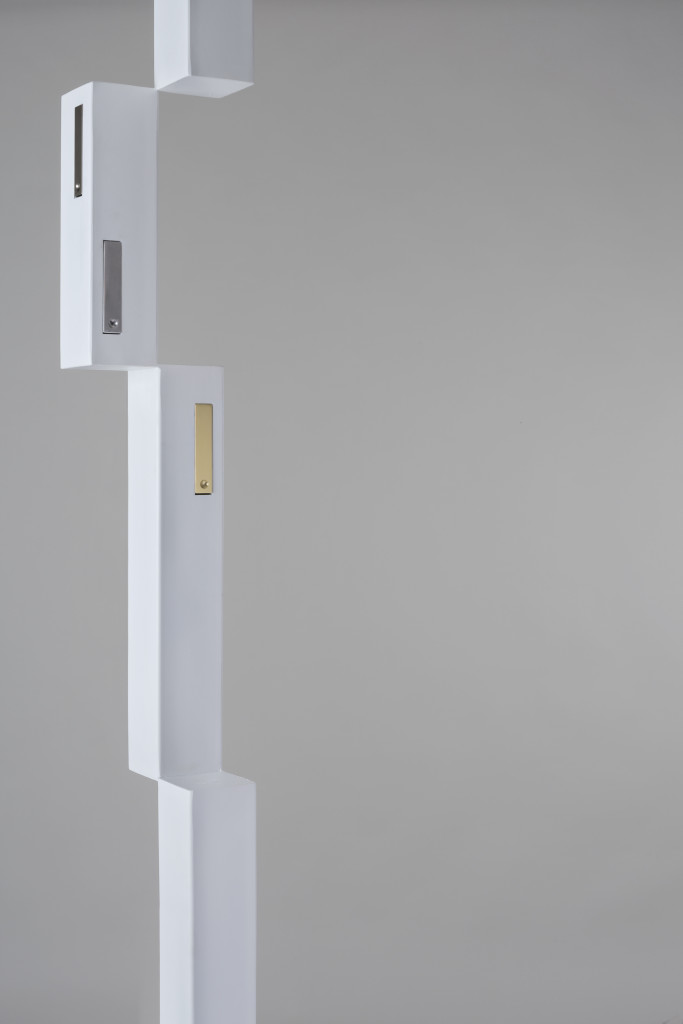Marco Ripa è un artista che ama la materia, lavora il metallo rendendolo leggero, crea opere di straordinaria delicatezza, in ossimoro con l’elemento di cui sono fatte: è questa la magia che avviene nella sua officina, la fusione di contrasti.
Marco inizia la sua carriera lavorando come fabbro tradizionale nell’officina dello zio, svolgendo l’attività di carpenteria: cancelli, ringhiere e quant’altro possa avergli conferito un’ottima manualità nella gestione della materia. Il problema di questa grande capacità era l’assenza di appagamento artistico, un bisogno fondamentale dovuto alla sua passione per l’arte e il design. Così, nel 2011 dopo un travaglio durato anni, nonostante la crisi economica, ha finalmente deciso di fondare la sua officina di lavorazione dei metalli prestando attenzione anche al lato artistico. Per il suo lavoro ha assunto un ruolo fondamentale la figura di Alexander Calder, scultore americano in cui ha potuto ritrovare la sua filosofia: “Realizzava principalmente sculture in metallo. Le sue sculture però erano leggere e mobili. Tutti noi siamo abituati ad associare al metallo peso e staticità. Calder ha sovvertito questi concetti donandogli leggerezza e movimento. Questo mi ha fatto percepire il metallo da un altro punto di vista. Da qui ho cercato di progettare oggetti che avessero queste caratteristiche”.
Lo spazio creativo di Marco ha un nome ben preciso: Officina Art & Craft. Questa definizione fonde più concetti e contaminazioni, primo tra tutti il suo interesse per l’arte e il design che lo ha spinto a studiare la storia del design. “Nelle mie letture ho scoperto John Ruskin e l’arts and crafts movement. A cavallo tra ottocento e novecento, quando iniziava la seconda rivoluzione industriale con le prime produzioni di massa un gruppo di artigiani, designer ed artisti iniziarono a pensare che questo avrebbe rovinato il rapporto tra cliente ed oggetto. Non più soddisfazione ed appagamento ma semplicemente acquisto. L’arts and crafts movement infatti sosteneva che la distanza tra progettista e rete di produzione avrebbe portato all’abbassamento della qualità. Soltanto lavorando a stretto contatto l’uno con l’altro il prodotto avrebbe avuto quel qualcosa in più che alcuni chiamano anima”.
E’ proprio questo concetto il principio fondante del lavoro di Officina Art and Craft, in un periodo storico in cui “Abbiamo la fortuna di trovare oggetti molto funzionali realizzati più o meno bene ma che hanno un grosso difetto: essere tutti uguali. Il fascino di avere un pezzo unico realizzato su misura è alto adesso più che mai. La voglia di distinguersi in questo momento di omologazione globale è la spinta con cui ho intrapreso la mia idea d’impresa”.
Partendo da questo concetto, l’idea di artigianato e di design si fondono: “Il designer è un progettista e l’artigiano è il realizzatore. Nel mio caso svolgo entrambe le funzioni. Tutti gli oggetti che realizzo nascono da un’esigenza. Da questa inizio a progettare qualcosa di utile e funzionale e perché no anche bello ed esclusivo”.
Per un artigiano e un designer è fondamentale la scelta dei materiali, secondo Marco sono elementi che si deve imparare a rispettare, non possono essere semplicemente modellati con la forza. “Vanno lavorati, scaldati al punto giusto, si deve usare il martello quando serve e la delicatezza quando viene richiesta. Ci sono giorni che una lavorazione proprio non riesci ad eseguirla. In un altro momento, magari a mente sgombra ed un approccio diverso esce in un lampo. Eppure la materia è la stessa. Evidentemente è cambiato qualcosa in noi e ci siamo adattati ad essa”.
Lavorare la materia vuol dire saper plasmare esattamente le proprie idee?
Plasmare la materia ha due tipologie. L’aspetto tecnico e l’aspetto artistico. L’aspetto tecnico viene fornito dall’esperienza e dalla conoscenza. L’aspetto artistico dall’anima. A volte si utilizza più il primo a volte la seconda ma i lavori migliori vengono quando si riesce a fonderli in un unico progetto.
Diamantina, una tessitrice equadoregna incontrata in una delle prime esposizioni che ho fatto in giro per l’Italia, mi ha citato questa frase di San Francesco che mi è rimasta dentro: “L’operaio lavora con le mani, L’artigiano con le mani e la testa, l’artista con le mani, la testa ed il cuore”.
Nel sito di Officina Art and Craft possiamo leggere una frase di Ruskin riguardo la sua idea di ornamento: “L’ornamento ha due sorgenti di piacere, la bellezza astratta delle sue forme, e il senso del lavoro umano e dell’attenzione che è stata spesa per fabbricarlo“. Ruskin così come William Morris e l’arts and crafts movement sono stati un punto di partenza per la realizzazione del sogno di Marco ed è interessante capire come le idee di oggi possano essere stimolate ed influenzata da una passione che porta lontano, fa studiare ed appassionare per portare infine un pensiero del passato nel presente e dimostrare quanto possa essere reale ed affascinante . Questa cultura è stata scoperta “Mentre dentro di me nasceva la voglia di intraprendere questo viaggio. Mi hanno dato la forza e la consapevolezza che questo percorso era percorribile. Non sapevo dove sarei arrivato ma sapevo di certo da dove partire”. E’ affascinante comprendere come una passione spinga ad iniziare un percorso nonostante molte incertezze e l’unica certezza di volerlo percorrere.
Da questa certezza sono nati uno dopo l’altro i progetti di Marco, nati prima su carta e ultimamente anche in digitale, grazie all’ausilio di programmi di progettazione 3D. “Si parte da un’idea o un’intuizione da cui si realizza un progetto di massima, si fanno le dovute correzioni e poi si passa al render per renderlo più reale possibile. Una volta avuta la conferma dal cliente passiamo alla realizzazione. A volte capita però di snaturare completamente il progetto iniziale. Lavorandoci sopra può succedere che viene l’intuizione bizzarra e di proseguire “a braccio”. Ne sono un esempio La lampada “Just Kids” ed il tavolo “Forma e sostanza”. Il progetto iniziale era molto distante da quello che poi ho realizzato. Mentre lavoravo sentivo che qualcosa non tornava. Non riuscivo ad avere un bilanciamento delle forme e non mi sentivo appagato. Sentiti i committenti ho chiesto se potevo improvvisare. Il risultato è stato un successo non tanto per le forme ottenute (tutto è soggettivo) ma perché ho realizzato qualcosa che li ha toccati nel vivo. Mentre creavo pensavo a loro e alle storie che mi hanno raccontato. Sono riuscito a creare qualcosa che ha cristallizzato per sempre quel momento e li ha toccati nel vivo”.
Parlando di opere che nascono dall’intuito, assumendo forme particolari , pongo la questione di ZZ top ed LSD: due sedute agli antipodi ed ugualmente affascinanti. Per poter realizzare queste idee è stato fatto uno studio di distribuzione dei pesi, per poterne assicurare l’assolvimento statico? Oppure le proprietà dei materiali utilizzati hanno permesso di realizzare qualsiasi tipo di forma?
Principalmente manifestano la mia schizofrenia! Spesso passo da uno stile pulito, minimale e rigoroso ad uno caotico ed apparentemente casuale. Alcuni dicono che non sembrano realizzati dalla stessa persona!
Il ferro è un materiale fantastico che ti permette di realizzare qualsiasi cosa: è resistente ma anche elastico. Avendo un’alta conoscenza della materia e bilanciando spessore e dimensioni lo si può sfruttare a proprio piacimento. ZZ Top è uno sgabello di uno spessore di soli 3 mm ma la costola laterale ci dà la giusta resistenza. In LSD (“Lucy in the sky with diamonds” Jon Lennon) sono stato attento nella costruzione della rete di ferro. Ogni disco di legno, infatti, tramite vari tondini forgiati scarica il peso direttamente a terra conferendo elasticità alla seduta. Ho dovuto collegare tra di loro i vari elementi per conferire anche la dovuta resistenza.
Parlando di opere che nascono dall’intuito, assumendo forme particolari , pongo la questione di ZZ top ed LSD: due sedute agli antipodi ed ugualmente affascinanti. Per poter realizzare queste idee è stato fatto uno studio di distribuzione dei pesi, per poterne assicurare l’assolvimento statico? Oppure le proprietà dei materiali utilizzati hanno permesso di realizzare qualsiasi tipo di forma?
Principalmente manifestano la mia schizofrenia! Spesso passo da uno stile pulito, minimale e rigoroso ad uno caotico ed apparentemente casuale. Alcuni dicono che non sembrano realizzati dalla stessa persona!
Il ferro è un materiale fantastico che ti permette di realizzare qualsiasi cosa: è resistente ma anche elastico. Avendo un’alta conoscenza della materia e bilanciando spessore e dimensioni lo si può sfruttare a proprio piacimento. ZZ Top è uno sgabello di uno spessore di soli 3 mm ma la costola laterale ci dà la giusta resistenza. In LSD (“Lucy in the sky with diamonds” Jon Lennon) sono stato attento nella costruzione della rete di ferro. Ogni disco di legno, infatti, tramite vari tondini forgiati scarica il peso direttamente a terra conferendo elasticità alla seduta. Ho dovuto collegare tra di loro i vari elementi per conferire anche la dovuta resistenza.
Rimanendo sul tema delle opere che parlano di scelte dovute all’intuito, penso a Touch, uno scrittoio di massima bellezza ed espressività che mi ha molto colpita e che racconta a suo modo il pensiero del suo creatore.
E’ un tavolo dal design semplice, quanto tecnico. Per avere leggerezza e resistenza ho utilizzato due lastre d’acciaio saldate insieme a sembrarne una. La seconda che tra l’altro è la parte più bella e caratteristica dello scrittoio, è anche la più importante e quella che da resistenza e tiene su il tavolo. E’ nascosta al normale punto di vista: si vede solo abbassandosi. Soltanto i curiosi possono ammirarla appieno!
Il design minimale è proprio questo. Esprimere concetti difficili in maniera semplice.
Queste idee forti, decise, con una loro distinta identità sono una sfida al pensiero moderno e ai tempi associati a questo determinato periodo storico. Quali sono state le difficoltà che hai dovuto affrontare per poter portare avanti la tua idea creativa?
Ho scommesso sulla voglia di farcela e sulle mie capacità. Il momento storico che stiamo attraversando è molto complicato ma se ci si presenta con un’idea nuova e un’immagine accattivante si può emergere. Mi è stato chiaro fin dall’inizio che per inserirmi in un mercato già popolato da marchi importanti e blasonati dovevo puntare sulla comunicazione e sull’innovazione. Ho da subito contattato un grafico moderno e molto preparato (Roberto Montani) e un fotografo di qualità (Marco Biancucci). Il lavoro svolto si vede. Chi guarda il sito capisce subito che dietro c’è un’idea e un progetto ben definito.
Per concludere la nostra intervista chiedo cosa consiglia Marco a chi, come lui ha deciso di investire la propria vita nelle sue idee.
Si deve partire da un progetto ben chiaro. Decidere cosa si voglia fare e quale fetta di mercato raggiungere. Circondarsi di gente preparata che possa aggiungere valore al progetto. Ma soprattutto di credere al proprio progetto d’impresa. Perché è questo di cui stiamo parlando. Spesso incontro designer, artigiani e auto produttori molto capaci e preparati ma vedono il proprio lavoro come un hobby. Lo scatto mentale tra un passatempo e un’azienda è molto grande e complicato ma può fare la differenza
[divider]ENGLISH VERSION[/divider]
Marco Ripa is an artist who loves materials: he works with metal, making it lighter and creating works of extraordinary delicacy, in oxymoron with the element of which they are made of: this is the magic that comes to life in his workshop, the fusion of contrasts.
Marco started his career working as a traditional smith in his uncle’s workshop, carrying out the activities of carpentry: gates, railings, and whatever has given him a great dexterity in handling the matter. The problem with his great skills was the absence of artistic fulfillment, a basic need due to his passion for art and design. So in 2011 despite the economic crisis, he finally decided to set up his own workshop also paying attention to the artistic side.
For his work he was able to find his philosophy in the figure of Alexander Calder, an American sculptor: “He realized mainly metal sculptures, but they were light and movable. We are all used to associating metal to weight and immobility. Calder has subverted these concepts, giving lightness and movement. This made me perceive metal from another point of view. Here it comes my attempt to design objects that have these characteristics”.
“Marco’s creative space has a quite precise name: Officina Art&Craft. This definition merges multiple concepts and contamination, first of all his interest in art and design that induced him to study the history of design. “In my reading I discovered John Ruskin and the arts and crafts movement. Between the nineteenth and twentieth century, when the second industrial revolution took place with the first mass production, a group of artisans, designers and artists began to think that this would ruin the relationship between customer and product. No more satisfaction and fulfillment but simply purchase. The arts and crafts movement in fact argued that the gap between designer and production network would lead to the lack of quality. Only by working closely with each other the product would have had that little extra that some call the soul”.
This concept is the founding principle of the work of the Art&Craft Workshop, in a historical period in which “We are fortunate to find very functional objects more or less well-made, but that have a big drawback: They are all the same. The allure of having a unique piece made to measure is higher now than ever. The desire to stand out in this time of global homologation is the thrust with which I started my business idea”.
In this way the idea of craftsmanship and design come together: “The designer is the one who designs and the artisan is the one who realizes. In my case I carry out both functions. All my objects come from a need. That’s where I start to design something useful and functional and why not also beautiful and unique”. For an artisan and a designer the choice of materials is crucial: according to what Marco says, they are elements we have to learn to respect. They cannot be simply shaped by force. “They need to be worked, heated to the right point, you have to use the hammer when you need it and the delicacy when required. There are days in which you just cannot be able to perform a manufacture and others in which, perhaps with a different approach, you easily get to do it. Yet the matter is the same. Obviously something has changed in us and we have adapted to it”.
Does working the matter mean knowing how to shape your own ideas? Treating materials has two sides: the technical one and the artistic one. The technical aspect is provided by experience and knowledge. The artistic one comes from the soul. The best works are those in which you put both of them! Diamantina, an Ecuadorean weaver that I met in one of the first shows I’ve done around Italy, quoted me these words of St. Francis that i still keep in me: “The worker works with his hands, the artisan with his hands and head, the artist with the hands, head and heart”. On the official Art&Craft website we can read a quote by Ruskin about his idea of ornament: “The ornament has two sources of pleasure, the abstract beauty of its forms, and the meaning of human work and the attention that has been spent to do it”. Ruskin as well as William Morris and the arts and crafts movement have been the starting point for the realization of the Marco’s dream and it is interesting to understand how the ideas of today can be stimulated and influenced by a passion that brings a thought from the past into present and demonstrate how real and fascinating it can be. This culture was discovered “while in me was born the desire to undertake this trip. They gave me the strength and the knowledge that this route was passable. I didn’t know where I would come but I knew for sure where to start”. It is fascinating to realize how a passion leads to begin a process despite many uncertainties and the only certainty of wanting to do it.
From this certainty were born all of Marco’s projects, firstly on paper and lately also in digital thanks to the help of 3D design programs. “It starts with an idea or vision from which we realize a rough draft, we make the necessary corrections and then switch it to a render to make it as real as possible. Once we have the confirmation by the client we move on to the realization of it. Sometimes however it happens to completely distort the original project by working on it and following a bizarre intuition.
“The lamp Just Kids and the table Forma e Sostanza are an example of it: the starting project was totally different from what i actually realized in the end. While working I felt that something was wrong. I wasn’t able to reach a balance of forms and I didn’t feel satisfied. I asked the clients if I could improvise. The result was a success not only for the forms that i obtained (everything is subjective), but because I realized something that really touched them. During the creation i was thinking of them and the stories they had told me. I managed to create something that has crystallized forever that moment”.
Talking about works that come from intuition, with particular forms, I want to ask you about ZZ Top and LSD: two seats totally different but equally fascinating. In order to realize these ideas did you study the weight distribution to be able to ensure the static performance? Or did the properties of the material you used give you the chance to obtain every shape you wanted? They are mainly a demonstration of my schizophrenia! I often move from a clean style, minimal and rigorous, to a chaotic and seemingly random one. Some say they don’t seem to be made by the same person! Iron is a fantastic material that allows you to achieve anything: it is strong but also elastic. Having a high knowledge of materials and balancing weight and size, you can exploit it to your liking. ZZ Top is a stool with a thickness of only 3 mm but the lateral rib gives us the right resistance. In LSD (“Lucy in the sky with diamonds” Jon Lennon) I carefully built the network of iron. Each wooden disc, in fact, through various forged rods releases the weight directly to the ground giving elasticity to the seat. I also had to connect the various elements to ensure the required resistance.
I also think of Touch, a desk of great beauty and expressiveness that really impressed me and that tells in his own way the mind of its creator. It’s a table of a simple and technical design. For lightness and strength, I used two steel plates welded together to look like one. The second one, which is the most beautiful and characteristic of the desk, is also the most important and the one that gives strength and holds the table. It is hidden at the usual point of view: you only can see it from below. Only the curious ones can fully admire it! This is the minimalist design. Express difficult concepts easily.
These strong ideas with their own identity are a challenge to modern thought and the time associated with this particular historical period. Which were the difficulties you had to face to go ahead with your creative idea? I bet on the desire to succeed and my abilities. The historical moment we are going through is very complicated but if you turn up with a new idea and a captivating image you can emerge. It was clear to me since the very beginning that to join a market already populated by important and famous brands I had to focus on communication and innovation. I immediately contacted a modern and well-prepared graphic designer (Roberto Montani) and a quality photographer (Mark Biancucci). You can now see the work that has been done. Have a look at the site and you will immediately understand the idea and the well-defined project behind.
To come to and end with our interview, I just wonder what Marco wants to recommend to those who, just like him, decided to invest their life in their ideas. You must start from a clear project. Decide what you want to do and which branch of the market you want reach. Surround yourself with prepared people that can add value to the project. But above all, believe in your business plan. This is what we’re talking about. I often meet very capable designers, artisans and manufacturers but they just see their work as a hobby. The mental gap between a pastime and a company is very large and complicated but it can make a difference.
Traduzione a cura di Mirko Morelli

